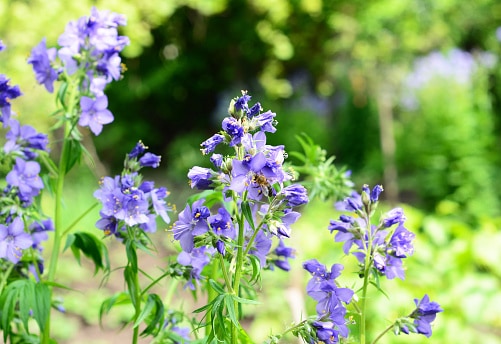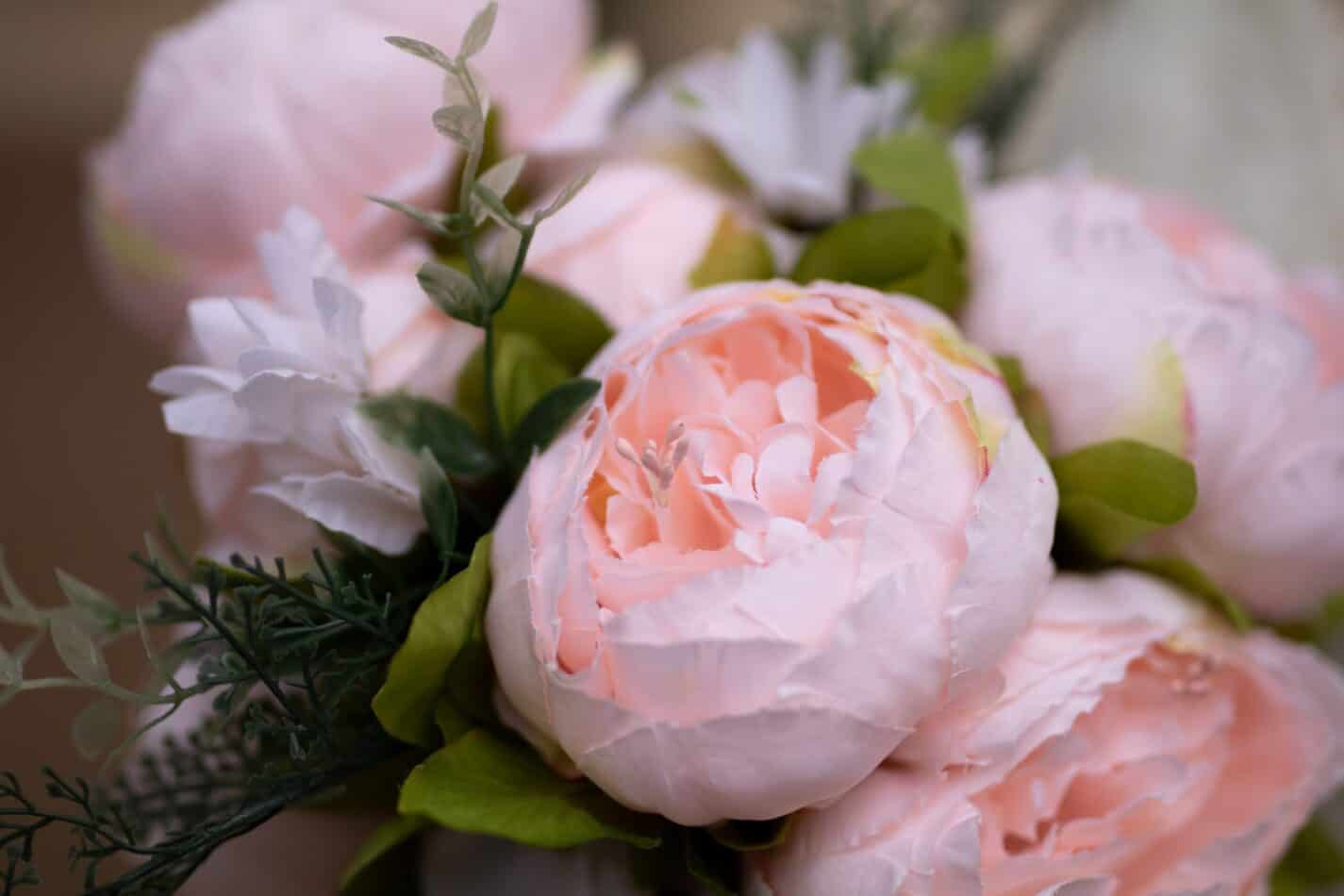Polemonium caeruleum, commonly known as Jacobs Ladder, is a type of flowering plant within the Polemoniaceae family. It is an upright spring perennial noted for its sprays of cup-shaped flowers sitting on top of lush green foliage. These flowers grow up to 24 inches tall and their leaves bear leaflets, which is why this flower is often called the Ladder to Heaven. The deep blue flowers have long yellow stamens, lending them a striking and elegant appearance. This flower is suitable for both pots and beds, making it a perfect decoration for both indoors and outdoors environments.
The etymology of Polemonium caeruleum is derived from Latin, with the genus Polemoniaceae being taken from the name of the Greek physician and botanist Polemon, who discovered this plant. The species name caeruleum is Latin for “blue”, referring to the flowers’ deep blue color. The old common name for Polemonium caeruleum was “Wild Balsam,” derived from the Latin family name for the species, “BALSAMINACEAE.”
How to Plant and Care for Jacobs Ladder
Jacobs Ladder is a hardy, easy to care for plant, although there are a few key points to remember when planting and caring for it. When choosing a location for your Jacobs Ladder, pick a spot that is exposed to full sun for at least a few hours a day, as this flower prefers bright light and four to six hours of direct sunlight will help the plant to thrive. Plant your Jacobs Ladder in loose, well-drained soil and keep the soil consistently moist. If your soil is not well-drained, you might need to add some organic matter to help it out and improve the drainage. During the summer months you should water your Jacobs Ladder regularly, but make sure to avoid overwatering, as this can lead to root rot. For best results, fertilize your Jacobs Ladder with a balanced fertilizer once every two weeks during the growing season.
Meaning and Symbolism
Since ancient times, Jacobs Ladder has been associated with heaven, usually represented in biblical stories as the ladder Jacob used to climb up to heaven. In Christian tradition, the Jacobs Ladder is seen as a symbol of guidance to the divine, and this representation has been used in religious artwork and jewellery for centuries. In the language of flowers, a Jacobs Ladder represents ambition and the idea of happy life being a journey that must be climbed up gradually, similar to the way Jacob climbed the ladder. It is also a symbol of humility and meekness, as its leaves are often bent down.
History, Mythology, and Religious Significance
In Christianity, Jacobs Ladder is seen as the biblical ladder of angels that Jacob saw in his dream in the book of Genesis in the Bible. To commemorate this event, many Christian churches contain imagery related to the Jacobs Ladder, and during certain church services, the minister will bless the congregation in the name of the ladder. In some instances, the Jacobs Ladder is seen as a symbol of the connection between heaven and earth.
In Wiccan myth and lore, the Jacobs Ladder is a symbol of spiritual protection, representing the connection between the divine and physical world. For many practitioners of Wicca, the Jacobs Ladder is a sacred plant and is used in spells for protection and to bring about spiritual enlightenment. In the language of herbs, Jacobs Ladder is also seen as an herb of protection and is thought to ward away negativity.
Flower Varieties and Their Defining Characteristics
There are a few different varieties of Polemonium caeruleum, all of which have slightly different characteristics. The most common varieties are:
- Polemonium caeruleum ‘Stairway to Heaven’ – This variety is the tallest with stems that grow up to 36 inches, and has dark-green foliage and blue flowers.
- Polemonium caeruleum ‘Blue Pearl’ – This is an evergreen variety with dimpled blue flowers and deeply-lobed foliage. Stems on this variety only reach around 8-24 inches.
- Polemonium caeruleum ‘Touch of Class’ – This variety grows to a maximum of 24 inches and has small, bright blue flowers and delicate foliage.
How to Pot and Repot Polemonium caeruleum
Jacobs Ladder plants should be repotted when they outgrow their current pot, usually every two years. To ensure that your Jacobs Ladder is planted and potted correctly, select a potting mix that contains peat and compost. This soil should be well-drained but still retain some moisture. When repotting, make sure to give your plant plenty of space, as Jacobs Ladder has a large root system and needs the space to grow. Once you have chosen the right pot and soil, your Jacobs Ladder is ready to be planted. Be careful not to break any of the roots while planting and make sure to water your plant thoroughly after potting.
How to Prune
Jacobs Ladder plants benefit from regular pruning to keep them looking their best. Pruning helps to keep the plant tidy and encourages new growth. Pruning should be done in early summer and again in mid-summer to remove dead or damaged leaves and flowers. To prune your Jacobs Ladder, cut back the stems and branches with a pair of sharp, clean pruning shears. Be careful not to cut too close to the main stem and make sure to remove any dead or diseased leaves, as these can spread the disease to healthy parts of the plant.
How to Propagate Polemonium caeruleum
Jacobs Ladder is an easy-to-propagate flower. There are two main methods that can be used: propagating from cuttings or propagating from seeds. To propagate from cuttings, take a cutting from a healthy plant and place it in a pot filled with moistened potting soil. Make sure to remove any flowers from the cutting in order to prevent it from using energy to grow plants. To propagate from seeds, sow them in a pot with moist soil in early spring and place the pot in bright, indirect light. Keep the soil consistently moist and you should see sprouts within a month.
Common Pests and Diseases
Jacobs Ladder is susceptible to some common pests and diseases. The most common are powdery mildew, aphids, and leaf miners. Powdery mildew is caused by a fungus that appears as a white powder on the plant’s leaves. To prevent this, avoid overcrowding and make sure to water your plants at the base rather than the leaves to reduce humidity. Aphids and leaf miners can be controlled with a strong spray of water or insecticidal soap. To avoid problems with pests and diseases, make sure to give your plants plenty of light and air circulation.
Questions and Answers
Q: What type of Polemonium caeruleum is best for indoors?
A: For indoor Jacobs Ladder plants, it’s best to look for the smaller varieties, such as ‘Blue Pearl’ and ‘Touch of Class’. These are more tolerant of the lower light levels indoors and benefit from more frequent watering than the larger varieties.
Q: Is Jacobs Ladder easy to care for?
A: Yes, Jacobs Ladder is a relatively easy-care flower that is perfect for gardens, pots, and containers. As long as you give it plenty of light and water, it should stay healthy and require minimal maintenance.
Q: How can I make my Jacobs Ladder flowers last longer?
A: To help your Jacobs Ladder flowers last long, make sure to give them a good amount of sunlight and deadhead them regularly. This will help to promote new growth and encourage the production of more flowers. Additionally, avoiding over-watering and fertilizing your plant regularly will help keep your blooms looking beautiful for longer.
Table Fact Sheet
| Jacobs Ladder | Polemonium caeruleum |
| Family | Polemoniaceae |
| Plant Type | Perennial |
| Mature Size | 8-36 Inches |
| Sun Exposure | Full Sun, Part Sun |
| Soil Type | Well-Drained Soil |
| Soil pH | 6.0-7.0 |
| Bloom Time | Late Spring to Early Summer |
| Flower Color | Blue |
| Hardiness Zones | 3-8 |
| Native Area | Europe, Asia, North America |
What we love from Amazon this week
Buy these wonderful flowers directly from Amazon:















